This car is quite popular in its class in Malaysia (from 1999 to 2003) which
consists of Honda Prelude BB7, Toyota Celica 1.8VVTL-i, Honda Integra
DC5 and Subaru Impreza WRX.
There were about 400 units of its kind throughout Malaysia between 2000 to
2007 (as a 5 years old recond). ALL of them were Grey Imports or
Reconditioned from Japan.
Here's the averaged 2nd hand value (as at 1 May 2010) of Nissan SIlvia S15:
Year:............1999........2000.........2001..................2002
Price (RM):..89k..........98k........108k (130k).....121k (145k)
(Varietta Convertible in Bracket)
Besides Coupe, Nissan also produced Limited Edition version called Silvia
Varietta (convertible). However, the Varietta's a NON-TURBO version (SR20DE)
with 5 speed manual in place of 6 speed manual and 4 speed Auto. Here are
some photos:
I do not have a Car for me to See/touch/drive and brag about it. All is not
lost, I came up with 3 sources, 1 Supertest from GOAUTO Australia,
Additional specs info from "nissans15.com".
Enjoy:
SOURCE 1: http://www.goauto.com.au/mellor/mellor.nsf/story2/5743A5F2479D4228CA256A54000A131B
SUPERTEST: Nissan / 200SX / Spec R coupe
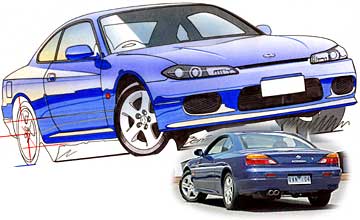
Overview

Featuring a traditional front-engine/rear-wheel drive layout, the suave coupe packs a mean punch thanks to the potent 2.0-litre turbocharged powerplant lurking under its bonnet.
A car that lacked visual sparkle previously is now a dead-set competitor for Subaru's Impreza WRX as the best bargan performance buy going around.
Model release dates: November 2000 - December 2003
Previous model
The same criticism cannot be levelled at its sleek successor.
The Car
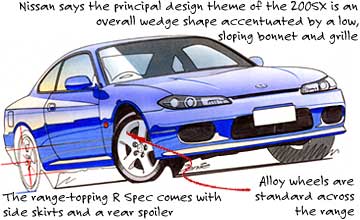
THE latest 200SX answers any criticisms levelled at its predecessor for its uninspiring styling. While the old model looked like a sedan in drag, the newcomer has swoopy Ferrari-like lines that ensure it stands out from the crowd. Its overall proportions are pleasing and finally do justice to the car's outstanding performance potential.
Did you know?
The 200SX is known as Silvia in Japan, a brand not unfamiliar to a lot of Australian motorists thanks to the large number of privately imported models here. The name Silvia dates back to the mid-1960s and the Nissan (not Datsun) Silvia coupe, based on the Datsun 1600/Fairlady chassis. The original Silvia was designed by German-American Albrecht Goertz.The Car - Seat Plan

THE 200SX is billed as a four-seater but there is precious little room for children, let alone adults, across the rear bench. Front headroom can be tight for taller people (particularly with the R Spec model's standard sunroof), while rear headroom is a problem for all and sundry. Getting into the rear seats requires some degree of athleticism.
Did you know?
The 200SX won MOTOR magazine's 2001 Performance Car of the Year awardThe Car - Seats
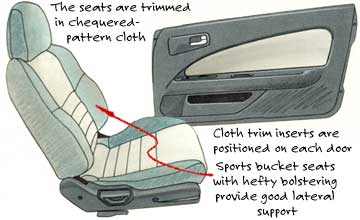
SPORTS bucket seats with hefty bolstering provide good lateral
support. The seats are trimmed in chequered-pattern cloth, with
cloth trim inserts positioned on each door. Seat adjustment is for backrest angle and fore-aft only
Did you know?
The 200SX is available in Spec S trim, as tested here, or as themore expensive Spec R, which adds a sunroof, six-CD stacker,
side skirts and rear spoiler.
The Car - Dash
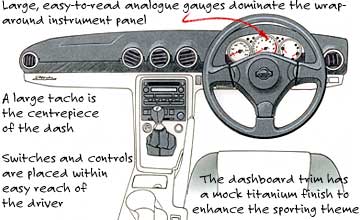
#THE 200SX's tilt-adjustable steering wheel and manual gearknob
are wrapped in leather in both Spec S and Spec R models, while a large, central tacho correctly dominates proceedings in the dash.
Did you know?
During 1972 Nissan headed towards genuine local manufacturing, opening a new head office in Dandenong, Victoria and installing an engine plant and vehicle assembly line at the Clayton Plant. In 1977local production topped 127,754 vehicles. Nissan closed the Clayton plant in 1992 and reverted to being a full-line importer.
The Car - Controls
THE contours of the switchgear have been designed for fingertip operation and uniform "feel". Ergonomics were a high priority with the front fascia design, while power window switches are located on the transmission tunnel in front of the gearshift. The steering wheel can be adjusted for height but not reach.The Car - Wheels/tyres
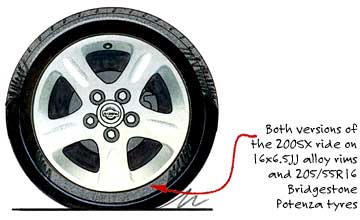
Both the Spec S and Sec R versions of the 200SX ride on simple,
easy to clean, five-spoke alloy rims measuring 16 x 6.0-inch and
wearing 205/55R16 Bridgestone Potenza RE010 tyres.
Did you know?
Independent performance testing has measured the 200SX's0-100km/h acceleration at just 6.34 seconds, and its 0-400m acceleration at a WRX beating 14.59 seconds.
The Car - Luggage

THE 200SX's rear seat can be folded down as one piece to boost luggage space, which is compromised in the boot by the intruding rear axle and diff, and bootlid hinges. The boot aperture is small and high.
The Car - What's changed
A LOT has changed since the horny 240Z, with many people lamenting Nissan's move toward big, heavy, ponderous coupes such as the 280ZX and 300ZX (barring the last generation). The 200SX was an altogether more sporting proposition than most of its ZX predecessors when introduced here in 1994. The latest iteration uses essentially the same ingredients as its predecessor, but a host of subtle tweaks and revamped styling have made it a far more attractive proposition. The five-speed manual gearbox of the superseded model is replaced by a new six-speed transmission, while the newcomer is shorter, narrower and lower than its predecessor.Did you know?
Much of Nissan's sporting heritage in Australia can be traced to its impressive rallying performances in the 1960s and 1970s. The legendary 1600 launched many rallying careers, thanks to its toughness, simplicity and tuning potentialThe Car - Stand out features
THE brilliant 2.0-litre turbocharged engine endows the 200SX with searing performance yet it is still easy to drive around town. The chassis delivers a fine balance between ride quality and handling, while styling has brought Nissan coupe diehards to blows over the years, with one camp yearning for the 240Z from the late-1960s and others who stand by their big, comfortable, luxo-cruisers. The 200SX is suitable for two people only - precious little room is left behind the front seats.The Car - Climate control
CFC-free air-conditioning is standard across the range. A four-speed rotary dial is used for the blower, with individual buttons for recirculation, air-conditioning and air circulation, and a slide mechanism for temperature. The five circular air vents on the dashboard hark back to the Datsun 240Z.The Car - Sound system
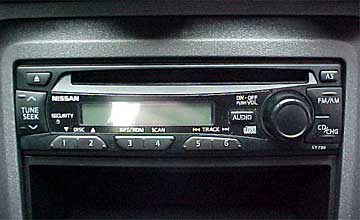
THE 200SX Spec S features a four-speaker radio/CD player,
while the Spec R gains a radio/cassette unit with six-stack CD
player.
The Car - Security
AN engine immobiliser is standard in both 200SX models. Thesecurity system is linked with the remote central locking keypad.
When the system is activated, any attempt to break into the car
will cause the hazard lights to flash and the horn to sound. The
remote keypad includes a panic alarm which triggers the horn
and hazard lights.
Did you know?
A six-speed manual transmission replaces the five-speed itemin the previous 200SX.
Our opinion
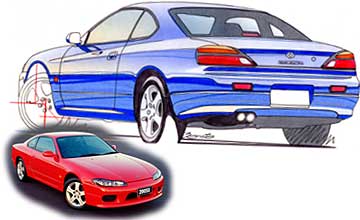
 We like Performance, handling, style, value for money
We like Performance, handling, style, value for money  Room for improvement Token rear seats, smallish boot
Room for improvement Token rear seats, smallish bootBy GAUTAM SHARMA 22/05/01
MEMO to Nissan: could you please build a car with searing
acceleration, limpet-like grip and drop-dead good looks? Oh,
and try and keep the price down.
Someone at Nissan was obviously listening because the new
200SX is everything a sports coupe should be. The turbo titan
offers bags of style and performance in an affordable and
easy-to-live-with package.
Although the 200SX badge made its Australian debut in late
1994, the model has been around in a number of different
guises since the 1960s.
Known as Silvia in Japan, the coupe has built up an enviable
reputation as a serious driver's car.
Enthusiasts have always relished its rear-wheel drive layout
and turbocharged, 2.0-litre, four-cylinder engine.
But in terms of outright sales, the 200SX has struggled in the
shadow of its previously more glamorous front-wheel drive
rivals. The Toyota Celica and Honda Prelude, for instance,
have in the past outsold the Nissan with ease.
This may have been in no small part due to the previous
200SX's pedestrian looks, despite Nissan's efforts to
sharpen up the front end in late 1996.
Thankfully, the latest iteration ditches the bland, sedan-in-
drag lines of the former model in favour of a sexier, more
curvaceous shape.

Its face is adorned by slanted, angry-looking headlights and an aggressive spoiler, endowing the car with a menacing presence.
Viewed from the side, the 200SX has distinct overtones of the
Ferrari 456M.
In our opinion, the entry-level Spec S - which does without the rear spoiler, side skirts, sunroof and CD stacker of the pricier Spec R -
is the more aesthetically pleasing package.
The only thing it lacks is a set of chunky 17-inch alloy wheels. The existing 16-inch rims look okay, but the car would assume a far
more purposeful stance on 17-inchers.
Nevertheless, the 200SX is still an eye-catching proposition and,
happily, its looks are easily matched by its performance.
The coupe's rear-drive layout has real allure to drivers who like the
idea of being able to "steer a car on the throttle" - in other words,
induce oversteer with a healthy dose of right welly.
Straight-line performance buffs will also be pleased. Nissan
claims the 200SX can accelerate from zero to 100km/h in 7.5
seconds, but Motor magazine covered the sprint in 6.34 sec-
onds when it tested the car in April 2001.
For the record, the standing 400-metre was dispatched in
14.59 seconds by Motor - putting the Nissan coupe on par
with the Subaru Impreza WRX.
So how does the 200SX do it? Although its engine is derived
from the 2.0-litre unit previously seen in the Pulsar SSS, the
addition of forced induction transforms it into a potent weapon.
The powerplant has perfectly square bore-stroke dimensions
and uses a twin-camshaft, 16-valve head and an intercooler to
extract maximum efficiency during the combustion process.
To compensate for the extra boost provided by the turbo the compression ratio is lowered to 8.5:1, with boost control and
variable valve timing controlled by the engine electronics, to
avoid pre-ignition or "detonation" problems lying in wait for
ill-designed forced induction engines.
Nissan's variable valve timing technology is similar to BMW's
VANOS system and works by controlling the camshaft position according to a number of variables including temperature,
#intake airflow, accelerator position and engine speed.
The net result: a none too shabby 147kW at 6400rpm and
265Nm of torque at 4800rpm.
Holding all this together is a chassis that borrows some
components from the Nissan 300ZX, such as the multi-link
rear suspension, although it has its own MacPherson strut
front end.
Nissan says the variable rate suspension bushes are filled
with fluid (silicone) to reduce noise. Meanwhile, wheelspin
is kept in check by a helical limited-slip differential - albeit
only in manual models.
Theory is all well and good, but the 200SX delivers the
goods where it counts - on the road.
Its ample power and relatively light weight could have resulted
in an unwieldy - even intimidating - package, but the car's well
sorted chassis and docile nature means this is not the case.
Driven gently, the 200SX is no more demanding to drive than
its Pulsar sibling.
Push it hard and you enter another realm. The turbo starts to
generate serious boost from about 2000rpm and any
subsequent prods on the throttle are accompanied by a
healthy shove in the back.
The surge of acceleration remains unabated to 6000rpm
and beyond, which means snatching higher gears as
quickly as possible becomes a priority under full throttle.
Fortunately, the slick shift quality and short, snappy throws
mean rowing through the six-speed gearbox is a pleasure
rather than a chore.
The perfectly spaced gear ratios are also well matched to
the torque curve and there is enough power to handle a
relatively high sixth gear while still providing reasonable
acceleration.
Noise levels are never intrusive - thanks partly to the muffling
effect of the turbo - but, no doubt, several hard-core performance
nuts will feel the urge to turf the standard exhaust in favour of
a more free-flowing (and noisier) drainpipe.
The 200SX is clearly a straight-line rocket, but it is not
averse to being hurled at corners - in fact, it relishes it.
The car's inherent balance means it remains poised and
generally forgiving under most circumstances.
Feed the power progressively through a corner and the car
assumes a neutral attitude and holds its line nicely. But a
more extravagant cornering style - tail-out oversteer - can
be achieved by skilful drivers who enjoy opposite-lock antics.
The whole exercise is facilitated by the Nissan's well-
weighted and communicative rack-and-pinion steering.
Ride quality, although on the firm side, is acceptable for a
sporting coupe.
Purists will appreciate the fact the 200SX is not loaded with
driver aids - anti-lock brakes and brake-assist being the only exceptions. Dual airbags are also part of the standard safety
feature list.
Accommodation definitely favours front-seat rather than
rear-seat passengers, who need to be either very small
or legless. The front seats are sporty, sculpted items that
provide good lumbar and lateral support, but shorter drivers
may complain the seats are set too low.
The simple, uncluttered dash and centre console layout is
aesthetically pleasing and in keeping with the sporting
character of the car.
Overall, there is plenty to like about the Nissan 200SX.
Its beautifully sculpted lines make it a far more visually enticing
package than its predecessor, while the subtle refinements to
the chassis add to its appeal as a driver's car.
The Subaru Impreza WRX still wins hands down if practicality
comes into the equation, but if rear-seat comfort and boot
space are not priorities then the Nissan has to be at the top
of your $40K performance car short list.
Mechanical
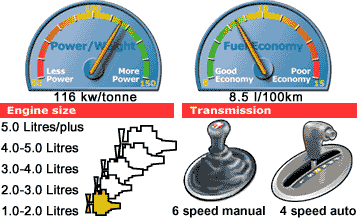
Mechanical - Plan views
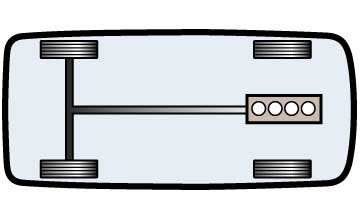
In true sports car fashion, the 200SX employs a longitudinal,
front-mounted engine driving the rear wheels.
Mechanical - Engine
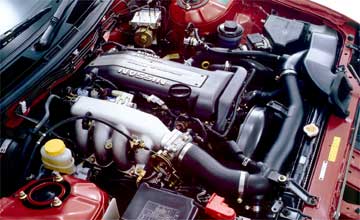
THE 200SX is powered by a 2.0-litre, twin-cam, 16-valve,
four-cylinder engine with an intercooled turbocharger and
variable valve timing. It produces 147kW at 6400rpm and
265Nm of torque at 4800rpm - not bad for a Pulsar unit with a turbocharger bolted on.
Official fuel consumption figures point to 10.0L/100km on the
city cycle (manual), but be prepared to pay extra for premium
unleaded petrol. The variable valve timing control system
modifies inlet valve timing to boost low-speed torque and
help eliminate turbo lag, while Nissan's Linear Charge
Concept combines a small turbocharger inlet for low-rpm
response with a large turbo compressor for top-end power.
A closed loop turbocharger relief circuit keeps impeller
speed up on throttle back-off. Sodium-filled exhaust valves
provide good heat dispersion, while the oil jet cooled pistons
were adopted from the twin-turbo Bathurst-winning GT-R
coupe of the early 1990s.
Did you know?
Nissan's first volume-selling sports coupe was the Datsun240Z of 1969. Since then, Nissan/Datsun sports coupes
have got progressively beefier - and pricier - and generally
ended up in the luxury end of the market. Upholding this
beefy and bold tradition, an "all new" 200SX arrived in
Australia in October, 1994, five years after its release in
Japan and sharing several components - including the
brakes and rear suspension - with the 300ZX.
Mechanical - Suspension
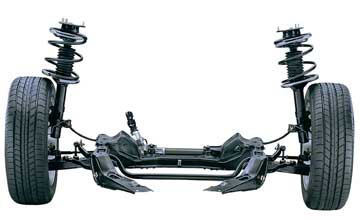
THE 200SX features long-travel MacPherson strut suspension
with transverse lower links, torsion rods and an anti-roll bar,
while a modified version of the multi-link system found on the
former 300ZX does the work at the rear. The variable rate
suspension bushes are filled with fluid (silicone) to reduce
noise. The Helical limited-slip differential (fitted to manual
models) assists the suspension by sensing any increased
demand on either drive wheel, and then distributing power
smoothly between the two wheels. Suspension has been
stiffened all around and front and rear anti-roll bars have
increased diameter and thickness. Wide-based diagonal
lower A-arms and lateral links and upper twin convergent
links are arranged to prevent dive and squat.
Did you know?
A 1997 left-hand-drive 200SX with dual airbags was crashtested by the US National Highway Traffic Safety
Administration, which gave it a very good report card. Only
a full frontal collision was undertaken, in which the driver's
side provided a 10 per cent or less chance of serious injury
(five stars, the highest possible rating). The passenger's
side provided an 11-20 per cent chance of serious injury
(four stars).
Mechanical - Transmission
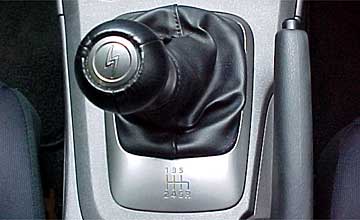
A SIX-SPEED manual and four-speed automatic transmission
are available across the 200SX range. The manual features a double-cone synchroniser system on second and third gears to
provide fast and smooth gearchanges. The electronically controlled automatic, codenamed DUET-EA, communicates with the engine's management system to provide smooth and timely shift points.
The standard six-speed manual transmission is a close-ratio unit
with an overdrive sixth. There's also a dual-mass flywheel and a
clutch with no hydraulic damper. Nissan claims this set-up minimises power loss. The automatic transmission interface controls engine
torque for quick, smooth shifts. Turbocharger control gives high
boost at low throttle openings and maximum boost at high speeds
in fourth and fifth gears (manual) and third and overdrive (auto).
Did you know?
Nissan Motor Company officially commenced operations inAustralia in 1966, but Datsuns had been privately imported
from Japan as far back as 1934. Soon after the company
displayed the Datsun 1200 model at the 1960 Melbourne
motor show, Australian automotive industry figure Sir
Lawrence Hartnett secured Australian distribution.
After gaining a mutual agreement with the Hartnett
Organisation, Nissan commenced local assembly of Datsun
Bluebirds in 1966 at the Pressed Metal Corporation plant in
Sydney, a year before the Datsun 1600 SSS was launched
and propelled Nissan to 12,000 sales - the seventh biggest
name in the Australian market. Local production bettered
20,000 in 1969.
Mechanical - Brakes
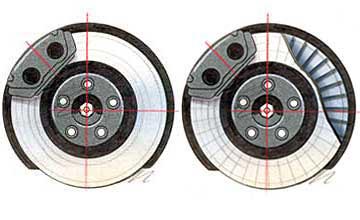
THE 200SX uses ventilated front disc brakes with four-pot calipers
and solid rear discs with single-piston rear calipers - the same specification as the former 300ZX.
Mechanical - Steering
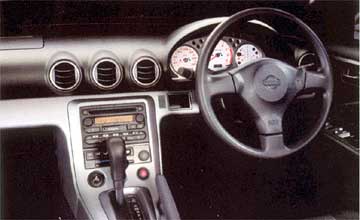
THE 200SX uses a power-assisted rack-and-pinion steering
system which varies the assistance depending on engine speed.
The system produces more power assistance at low speeds,
helping with manoeuvres such as parking. At higher speeds
power assistance drops and provides better road feel. Turning
circle is 9.6 metres and there are 3.1 turns lock to lock.
Did you know?
More 200SXs were sold in the first two months of sale than theprevious model managed in its final full year.
Safety
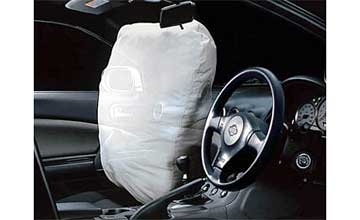
DUAL airbags, anti-lock brakes and brake assist are standard
in both the S Spec and R Spec 200SX. Brake Assist delivers
enhanced pedal pressure for extra stopping power, while
occupant protection measures include front crumple zones,
anti-intrusion bars, bonnet buckling creases and safety stops
and reinforced roof pillars. Halogen headlights provide excellent
visibility at night.
Did you know?
Manual versions of the 200SX use the same helical limited-slip differential as the hallowed Skyline GT-R coupe.RIVALS:
| Nissan 200SX | Subaru Impreza WRX | Honda Integra Type R | |||||
| PRICE - RETAIL (Accurate at time of publishing) | |||||||
| $40,990 | $43,300 | $43,800 | |||||
| TRANSMISSION | |||||||
| Six-speed manual/four-speed auto | Five-speed manual | Five-speed manual | |||||
| DRIVING WHEELS | |||||||
| Rear | All | Front | |||||
| ENGINE | |||||||
| Front-mounted 1.998-litre DOHC 16-valve turbocharged, intercooled inline four-cylinder | Front-mounted 1.994-litre DOHC 16-valve turbocharged, intercooled flat four-cylinder | Front-mounted 1.797-litre DOHC 16-valve in-line four-cylinder | |||||
| MAX POWER | |||||||
| 147kW | 160kW | 141kW | |||||
| LENGTH | |||||||
| 4445mm | 4405mm | 4395mm | |||||
| WIDTH | |||||||
| 1695mm | 1730mm | 1695mm | |||||
| HEIGHT | |||||||
| 1285mm | 1440mm | 1320mm | |||||
| WEIGHT | |||||||
| 1265kg | 1390kg | 1087kg | |||||
- Code: SR20DET
- Turbocharged, intercooled 1.998-litre 16-valve DOHC EFI four-cylinder
- Power: 250ps at 6400rpm
- Torque: 265Nm at 4800rpm
- Bore x stroke: 86 x 86
- Compression ratio:8.5
- Weight distribution: 51 (front): 49 (rear)
SPECIFICATIONS:
ENGINE:
- Six speed manual/four-speed auto
TRANSMISSION:
- Front: independent MacPherson strut system with coil springs and anti-roll bar
- Rear: independent multi-link system with coil springs and anti-roll bar
SUSPENSION:
- Power-assisted rack and pinion
- Turns lock to lock: 3.1
- Turning circle: 9.6 metres
STEERING:
- Length 4445mm
- Width: 1695mm
- Height: 1285mm
- Wheelbase: 2525mm
- Front track: 1470mm
- Rear track: 1460mm
- Kerb weight: 1265kg (manual) 1285kg (auto)
- Fuel tank: 65L Premium Unleaded
DIMENSIONS:
END OF GOAUTO Australia's review.
SOURCE 2: (http://nissans15.com/spec.htm)
Transmission SR20DET SR20DET/DE
6-speed manual 4-speed auto
1st gear ratio 3.626 2.785
2nd gear ratio 2.200 1.545
3rd gear ratio 1.541 1.000
4th gear ratio 1.213 0.694
5th gear ratio 1.000 -
6th gear ratio 0.767 -
reverse ratio 3.437 2.272
final drive 3.692 3.916/4.083
Colour (source:http://nissans15.com/spec.htm)
Body Colour Options| Code No | Colour Name | image |
| AR2 | Signal Red | |
| BN5 | Pale Aquamarine (metallic) | |
| WV2 | Pewter (metallic) | |
| TV3 | Cobalt (metallic) | |
| EV1 | Lightning yellow | |
| WK0 | Pearl While (3 coat pearl) | |
| KH3 | Super Black |
END OF SOURCE 2.




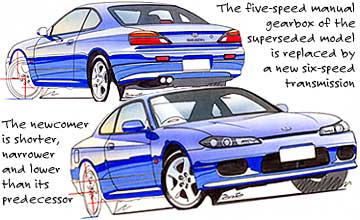
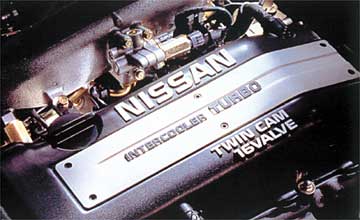
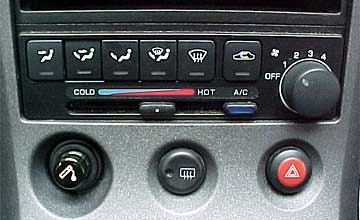
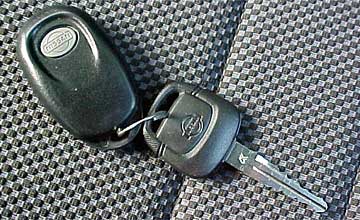


Great Blog,Thanks for sharing such beautiful information with us. I hope to will share some more information about lightning arrester specifications india. Please visit our website lightning arrester specifications india
ReplyDelete